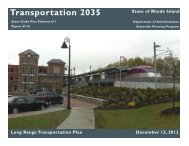Design for Social Sustainability â Saffron Woodcraft, 2010
Design for Social Sustainability â Saffron Woodcraft, 2010
Design for Social Sustainability â Saffron Woodcraft, 2010
Create successful ePaper yourself
Turn your PDF publications into a flip-book with our unique Google optimized e-Paper software.
4.1 AMENITIES & SOCIAL<br />
INFRASTRUCTURE<br />
New communities need services<br />
and support, not just buildings<br />
“If we are to have any chance of creating vibrant new<br />
communities that offer residents quality of life and that open<br />
up new opportunities – communities that are well balanced,<br />
integrated, sustainable and well connected – then we have<br />
to think about building <strong>for</strong> the wider needs of the whole<br />
community, not just focus on building homes.”<br />
A good place <strong>for</strong> children? Attracting and retaining families in inner urban mixed income communities, Emily<br />
Silverman, Ruth Lupton & Alex Fenton, Chartered Institute of Housing/Joseph Rowntree Foundation (2005)<br />
Barking Reach, London, UK<br />
24 DESIGN FOR SOCIAL SUSTAINABILITY<br />
Experience from around the world has shown<br />
that new communities need local services<br />
like schools, shops and public transport, at<br />
an early stage. Equally important though are<br />
the less visible types of support that make<br />
people feel at home in an area and create<br />
opportunities to meet other residents; like<br />
community and cultural activities that create<br />
a sense of shared history, and community<br />
workers who can help residents to meet their<br />
neighbours and enable residents to set up<br />
their own local projects.<br />
This type of social infrastructure needs to be<br />
in place early in the life of a new community<br />
– preferably be<strong>for</strong>e new residents move<br />
in. Central to the English New Towns<br />
concept was the idea of ‘walking distance<br />
communities’ where each neighbourhood<br />
would contain a school, shops, post office,<br />
chemist, church, pub, community centre and<br />
sports facilities. A review of transferrable<br />
lessons from the New Towns 31 to provide<br />
practical lessons <strong>for</strong> England’s new growth<br />
areas concluded that,<br />
AMENITIES & SOCIAL INFRASTRUCTURE 25
















